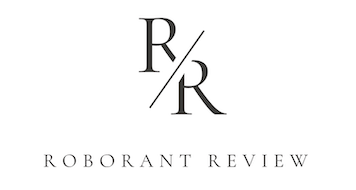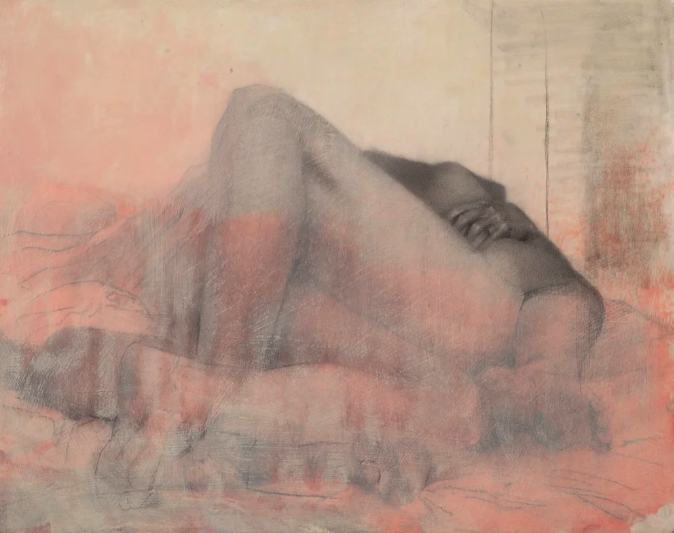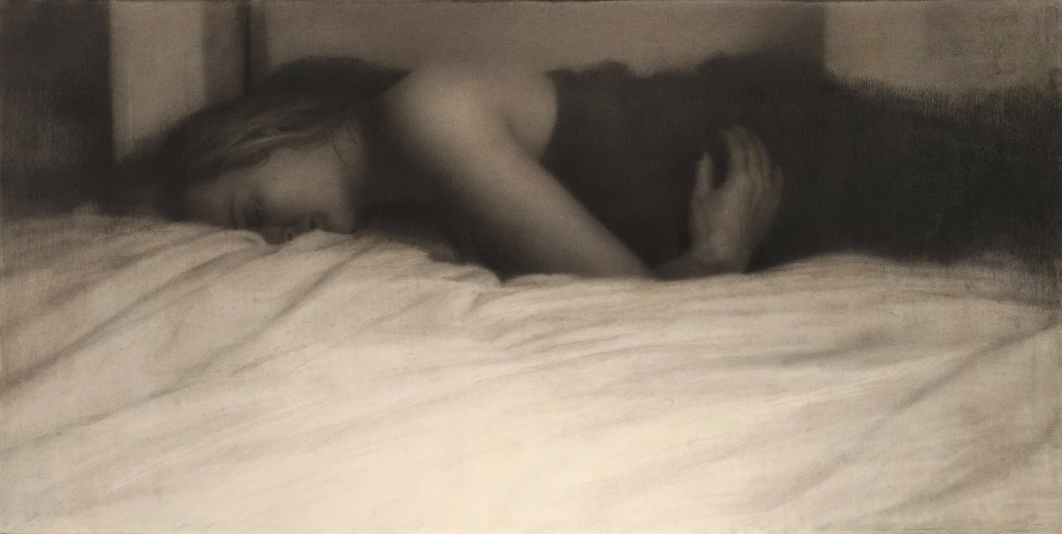Abi Joy Samuel & Zachary Oldenkamp, Dialogues, Ryan Graff Contemporary
By: Hugh Leeman
Abi Joy Samuel and Zachary Oldenkamp's exhibition Dialogues at Ryan Graff Contemporary brings together the intimate embrace rendered in Oldenkamp's graphite and charcoal works on paper, seemingly whispered into existence like words in half lit rooms, glancing across lovers' chests, with Samuel's minimal figurative paintings, whose aggressive brushstrokes transmit a visceral vitality imbued with inner turmoil. Samuel and Oldenkamp's creative conversation cast the viewer into an incongruous ocean where waves and troughs come together, forming an emotional texture of palpable vulnerability.
Abi Joy Samuel, from England, describes herself as an expressionistic figurative artist. Based in London, she often depicts her own body in vulnerable positions, transmitting a tension between tender human form and aggressive mark making bordering on violent, evoking a Jungian attempt to integrate the shadow into the self. She notes that, "there is something flowing through me and we are essentially vessels and I think human beings we have a responsibility to try and access that because it does rear its head in ugly ways otherwise."[1]
(L) Abi Joy Samuel, What is Left, Oil on canvas, 14.1 x 2O.5 inches (R) Tracey Emin: ‘It was all too Much’, 2018 // © Tracey Emin.
Samuel's intensity summons Tracey Emin's raw physicality through energetic brushwork and a scrawling calligraphic angst, eliciting Cy Twombly. Her minimal high contrast palette gives as much voice to negative space as to figures constructed in gestural strokes of reds with bits of black and white. Despite artworks with such potential for pathos and channeled anger, she speaks with youthful wonder at the beauty of the art-making process, saying it is "kind of life changing because you can literally take the world around you and see it on your paper, I just think that's brilliant."[2]
Zachary Oldenkamp, a San Francisco-based American, uses a soft diffusion of light and curving human forms to guide one's eyes into the unknown, combining ambiguity with sharp realism to depict scenes steeped in oxytocin. Tightly cropped compositions situate the viewer within moments of passion, often focusing on feet emerging from sheets. Individuals and partners remain anonymous, yet a biography of lovers is outlined through forms realistically rounded in the toned poetry of flesh's intimacy.
(L) Zachary Oldenkamp, Suddenly it Gets Easy, Charcoal and graphite on paper, 4 x 2 inches
(C)Georges Seurat, Seated Boy with a Straw Hat, 1882. Conté crayon, 24.1 x 31.1. New Haven, Yale University Art Gallery
(R) Zachary Oldenkamp, Waltz, Charcoal and graphite on paper, 4 x 2 inches
Oldenkamp's charcoal backgrounds create a dramatic chiaroscuro effect that evolves into the folds of white sheets or the inverse, in which detailed body parts in light emerge from within charcoal-rich linens, recalling the technical impact of Georges Seurat's Boy with a Charcoal Hat. Oldenkamp's modeling develops a meditative mood that mostly resists the voyeuristic gaze, as we are only allowed to see bodies in positions that often leave the act of coitus cropped off the edge of the artwork or concealed beneath sheets and shoulders. Such effects invite us to something more intimate than sex, the human potential for psychological connection.
The confluence of Oldenkamp's tender intimacy and Samuel's unsettling intensity comes together most convincingly in their collaboration, Untitled. In the charcoal and graphite work on paper, just 14" x 17", all the pain of a spurned lover wells up. The viewer is situated just past the foot of the bed, looking down at entangled legs beneath sheets and the embrace of lovers whose faces we finally see, delicately rendered yet deliberately destroyed as anger that seethes of betrayal has scratched them out. The man's face exists yet only under the graffiti of scratches; it's the top half of the woman's face, though, that has gotten the worst of it, as the flames of pain burned away echoes of a bygone affection, the ashen edges of anger crawled across her forehead, nose, and hair. What once was, no longer is, yet the tattered memory remains, suggesting human nature's dynamically entangled bedfellows, attachment and abandonment.
(L) Weight Beneath, Oil on paper, 11.8 x 15.7inches, (R)Abi Joy Samuel, Be You but Not Too Much, Oil on canvas, 39.4 x 31.5 inches
Samuel's titles and imagery extract themselves from a dark pathos of poetry and the vulnerability of diary. In Be You but Not Too Much, a gestural oil sketch shows us what appears to be love's embrace, the picture plane developed through negative space, a face and a mouth pulled towards an ear, perhaps murmuring the words of the artwork's title into one's conscience, telling of the tension between rejection and acceptance. Such tension is amplified in the oil on paper work Weight Beneath as two forms suggesting a sexual act are rendered in red and black. A form like a hand from the figure on its back pushes at the suggestion of a face above. Is it rough love, internal angst, or is the human form just a weight beneath aggression, the psyche, or that of the world? Like much great art, the figure's abstraction allows us a place to water the fertile fields of imagination's fear and fantasy.
The profundity of Samuel's work is her ability to synthesize insecurity and channel it into creation. In Overcome, breasts framed by bent legs rendered several times, suggest movement, as a hand nears the face, almost in anguish. Yet, we won't know as much from the identifiable forms as from the aggressive brushstrokes in black that eliminate the face and turn into the edge of what appears to be a bathtub. Despite the absence of all facial features, the artist has created a compelling self-portrait.
(L) Zachary Oldenkamp, Expanse I, Charcoal and graphite on paper, 7 x 7 inches , (R) Expanse II, Charcoal and graphite on paper , 5 x 7.75 inches
Oldenkamp's titles and imagery speak romantically of embodied connection, as in Expanse I, the embrace conveys less a sense of the act of coitus and more one of lovers whispering to one another, untethered to daily life's constraints. Yet, in Expanse II, the work leaves behind suggestion, whispers, and romantic embrace, trading it for a direct depiction of two people engaged in sex, though far from obscene, the work lends itself to voyeurism as we are left no doubt about what is taking place. The artist maintains elements of privacy and anonymity while heightening emotional tone as the heads and faces are cropped or covered by a lover's back, and the dramatically shadowed setting ranges from dark charcoal black to a near pure white pillow pushed aside amidst the physicality of the moment.
The corporeal landscape of connection found in Expanse I and Expanse II expands in Vacuum, where a clothed woman lies face down on a bed, her arms wrapped around herself, right hand resting on the left side of her abdomen. The sheets' folds and pleats pull us towards her face, largely obscured under the weight of its compression into the soft of the bed. Is she in physical pain, longing for a lover, experiencing exhaustion, or the anguish of isolation? The ambiguity of emotion, the abstraction of form, and the contrast of light push Vacuum towards the height of Oldenkamp's oeuvre. Clearly, in all of his artworks, he has incredible technical acumen, yet here he offers something more, a place for the 21st century to ponder the unedited elements of itself.
(L) Abi Joy Samuel, Grief, Oil on canvas, 76.8” x 53.1 “, (R) Zachary Oldenkamp, Indefinite, Charcoal and graphite on prepared paper, 11 “x 7 “
Abi Joy Samuel and Zachary Oldenkamp's exhibition Dialogues's incongruous ocean of emotion spans the technical spectrum from Oldenkamp's western academic traditions in technique rendering the modern nude enveloped in contemporary psychology's search for connection in a deeply disconnected world to Samuel's break from traditions to deliver unsettling emotions evoking existentialism's wrestle with isolation and anxiety birthed on the dreaded bed of uncertainty. The artists offer the viewer two unique lenses through which to see the self. Oldenkamp's lens of Sfumato-like transitions is a contemplative examination of intimacy, while for Samuel, fractured forms and smeared pigment suggest the morphing of emotion and internal instability.
In a world where everything but genuine psychological intimacy is more accessible than ever, alienation, despair, and the search for connection persist like a wound that won't heal. Oldenkamp and Samuel's Dialogues plays such chords of humans' animalistic nature floating upon that which remains amidst society's ocean of change, corporeal vulnerability's intimate symphony with interdependence, through their art, we are reminded of human song amidst the societal noise.
Citations:
1. Incubus Update. “Brandon Boyd With Abi Joy Samuel on Paintguide’s Instagram Live. 2/23/21.” YouTube, 23 Feb. 2021, www.youtube.com/watch?v=crPXqfqCUYs.
2. NeoLucida. “NeoLucida Artist Profile: Abi Joy Samuel.” YouTube, 29 Jan. 2024, www.youtube.com/watch?v=l2wN1SOycMs.
















